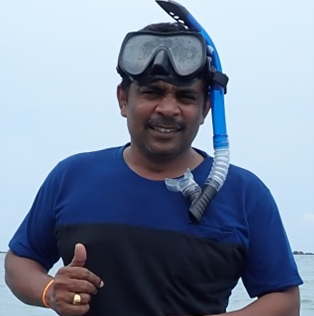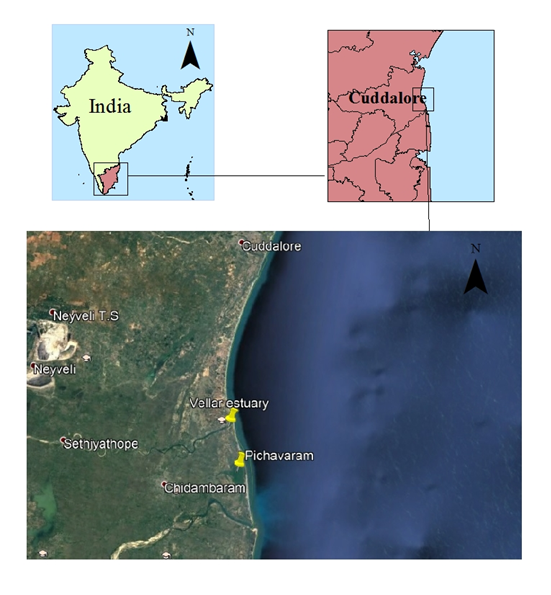IUCN/SSC Otter Specialist Group Bulletin

©IUCN/SCC Otter Specialist Group
Volume 39 Issue 1 (February 2022)
Citation: Utthamapandian, U., Sutaria, D., and Saravanakumar, A. (2022). First Photographic Record of Smooth-Coated Otters (Lutra Perspicillata Geoffroy 1826) in Vellar Estuary, Northeast Coast of Tamil Nadu, India IUCN Otter Spec. Group Bull. 39 (1): 16 - 21
First Photographic Record of Smooth-Coated Otters (Lutra Perspicillata Geoffroy 1826) in Vellar Estuary, Northeast Coast of Tamil Nadu, India
Udhayakumar Utthamapandian1, Dipani Sutaria2*, and Ayyappan Saravanakumar1*
1Centre of Advanced Study in Marine Biology, Faculty of Marine sciences, Annamalai University, Parangipettai, Tamil Nadu – 608 502, India
2 Adjunct faculty, College of science and engineering, James Cook University, Townsville, Australia
*Corresponding Author Email: asarvaan@gmail.com
(Received 3rd June 2021, accepted 7th August 2021)
Abstract: The presence of the smooth-coated otter (L. perspicillata) in the estuary of River Vellar has been confirmed by sighting and interview surveys. A family of smooth-coated otters was observed in a stream, hunting and eating fish from fishermen’s nets, resting and swimming around during the end of morning low tide. This is the first study that confirms the presence of otters here. The next closest known record is from Pichavaram which is about 6km south of the Vellar estuary. The family in the Vellar estuary consisted of ten otters; they were social, showing parental care. The report suggests the available rich biodiversity of the river which should come under conservation criteria.
Keywords: Smooth-coated otters, Vellar estuary, Tamil Nadu, Pichavaram
INTRODUCTION
The Tamil Nadu coastline comprises of 15% of the 1076km of Indian coastal stretch consisting 13 districts. A wide range of ecosystems including mangroves, wetlands, estuaries, lagoons and related biomes (Ramesh et al., 2008) are found along this coastal stretch of Tamil Nadu. Occurrence of Smooth-coated otters could be an indicator of abundance of prey, but they also known to adapt to the changes in land use patterns and anthropogenic led changes in habitat. Interview surveys around the regions of wetlands of Tamil Nadu, has suggested the presence of otters but this is the first study that confirms their presence in the Vellar estuary by means of direct observation.
Three species of otter have been reported in India (Smooth-coated otter, Eurasian otter and Small-clawed otter) (Reuther, 1999). Among these, smooth-coated otters have been reported nationwide while other two species are restricted to some specific locations and they are not reported in central and south India (Hussain and Choudhary, 1995; Forster-Turley and Santiapalli, 1990). The distribution of suitable habitat for smooth-coated otters is quite high but these areas are also nearshore or in estuaries that are prone to unmanaged development and infrastructure growth, making this species exposed to a range of threats. Smooth-coated otters remain one of the least studied species in Asia and are classified as insufficiently studied by the IUCN Red list and are in schedule II in the Indian Wildlife Protection Act, 1972. The lack of knowledge of smooth-coated otters throughout their range, limits the conservation strategy required to conserve the species (Hussain and Choudhary, 1995).
STUDY AREA
Cuddalore district of Tamil Nadu possesses some remarkable wetlands and coastal ecosystems of Tamil Nadu (Fig.1). The coastal regions such as Cuddalore port, Parangipettai, Samiyarettai, Periyakuppam are remote fish catching sites. The wetlands and backwater ecosystems include Pichavaram, Killai R.F., Thiruchchopuram are locations that possess suitable environments for a range of megafauna.
DETAILS OF THE SIGHTING
A group of otters were seen during the early morning hours (5.30 AM to 7 AM) on 15th April, 2021, under the parangipettai railway bridge which is across the Vellar estuary and is one of the locations of the river which is utilized the most by fishermen (Fig. 2). During the morning hours, otters were seen, catching fish from the gill nets of the fishermen. There were ten otters in the area of which eight otters remained in the southern bank of the river after catching the fish from the nets while two pups were seen swimming and catching fish below the bridge which was half a kilometer away from the rest of the pack (Fig. 3). At 7 am the two pups swam back towards the pack (Fig. 4) and they moved into the stream that runs into the dense mangrove forest. After the pack had moved upstream into the forest, pugmarks were observed along the bank of the river closer to the mangroves (Fig. 5).
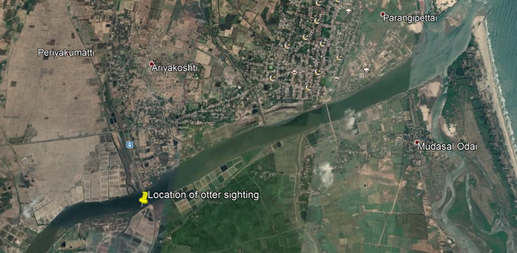
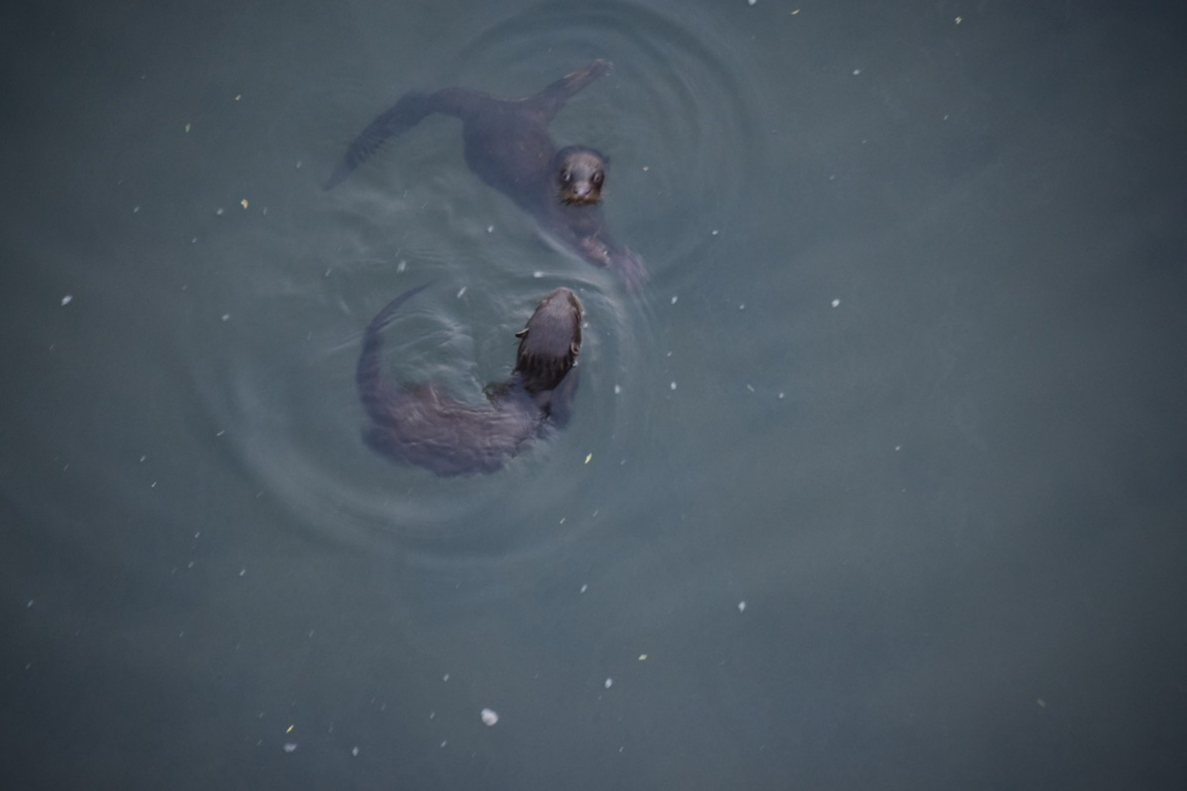
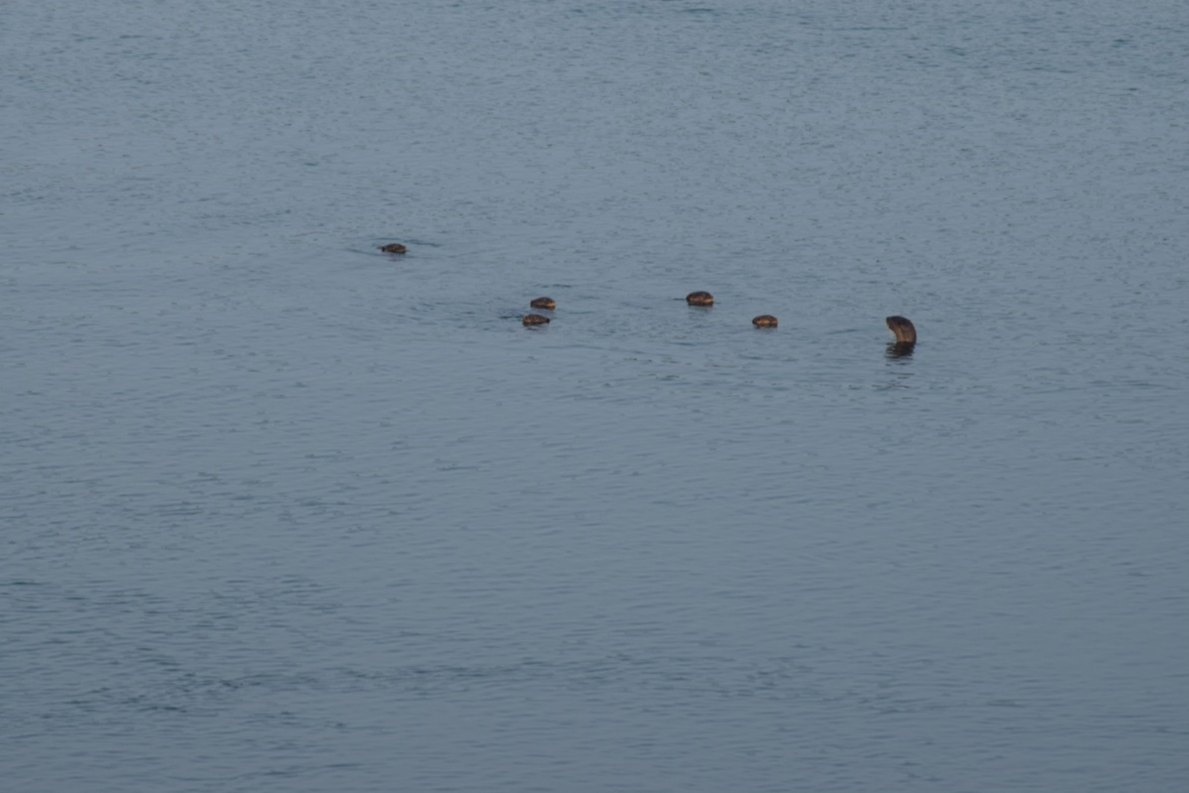
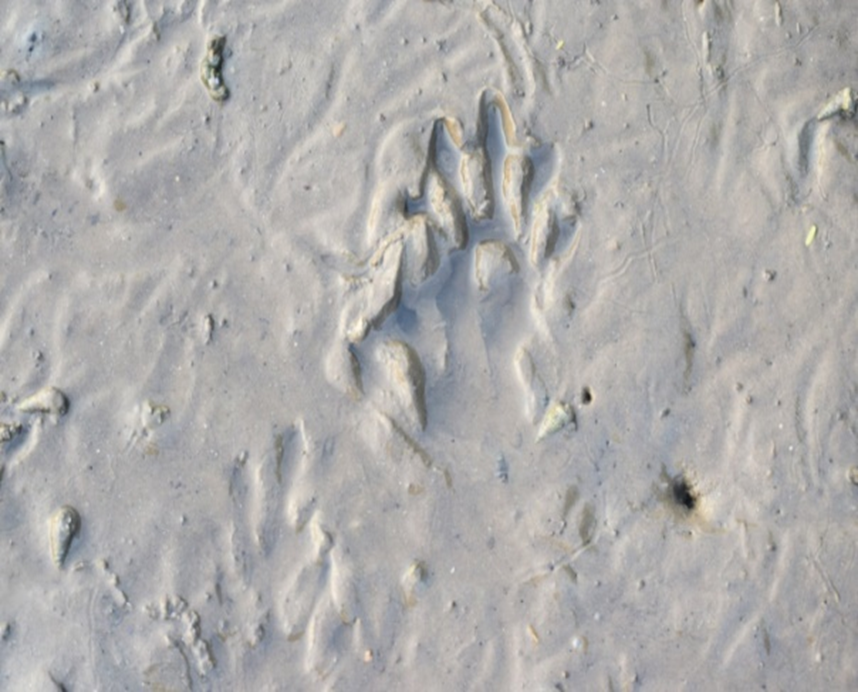
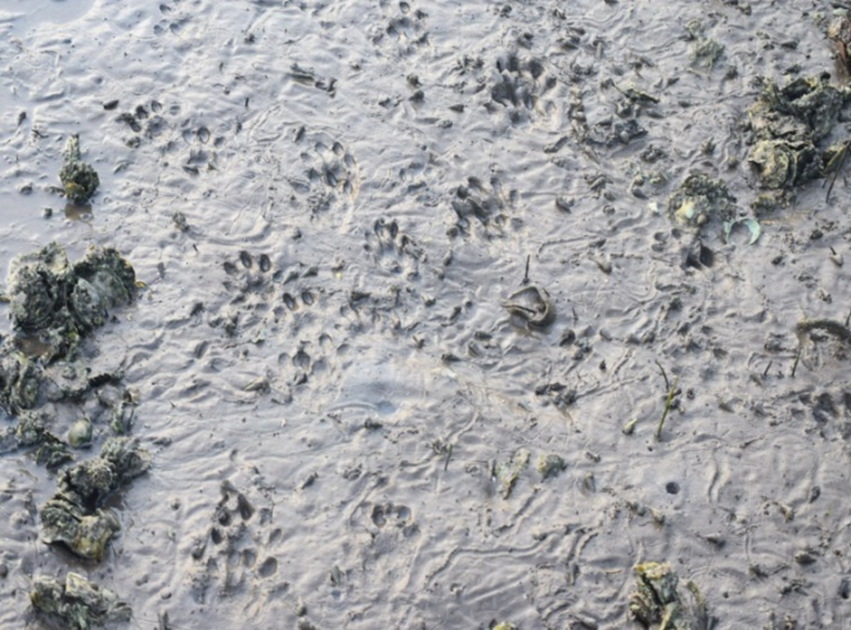
RESULTS
The place where the sighting occurred is an active fishing ground most of the year using gill nets and cast nets. The fishery resource in the location is abundant with catch of Etroplus suratensis, Mugil cephalus, Lates calcarifer and mud crabs and oysters. The interview surveys were carried from local fishermen following the survey questionnaire. It revealed that the otters’ adaptation in the region which catch fish from the gill nets leading to conflict with fishermen due to the cost of net damage and loss of fish catch.
CONCLUSION
We are not yet sure if this pack of otters is resident in this stretch or uses it seasonally. Our future study will look into these questions of distribution, space use and habitat mapping. We will also be working with local communities to collect sighting information and also to study the interactions between fishermen and otters – in relation to the type of fishing carried out. The next closest sighting of otters has been confirmed from Pichavaram and Kille reserved forests approximately 6km from here.
The construction of hydropower plants, ports and other infrastructure projects in coastal stretches of India, remains the key threat to the presence and distribution of otters throughout its range, along with the other threats including declining prey abundance and water contamination (Hussain et al., 2008). Vellar estuary is still free from a host of these anthropogenic threats and offers a suitable site for community inclusive conservation of otters. Fishing in this estuary is still small scale and the fishery is mainly for sustenance and small local markets giving us the chance to reduce conflicts between fishers and otters.
Acknowledgements: We are very grateful to the Director and Dean of the Centre for Advanced Study in Marine Biology (CASMB), Annamalai University for the constant encouragement for this and future works.
REFERENCES
Foster-Turley, P., Santiapillai, C. (1990). Action plan for Asian otters. In Otters: An Action Plan for their Conservation IUCN/SSC Otter Specialist Group, 52–63.
Hussain, S.A., Choudhury, B.C. (1995).Seasonal movement, home range and habitat use by smooth-coated otters Lutra perspicillatain National Chambal Sanctuary, India. In: Proceedings of VI. International Otter Colloquium, Pietermaritzburg. Reuther, C., Rowe-Rowe, D. (Eds.). Aktion Fischotterschutz Hankensbüttel. Habitat, 11: 45-55
Hussain, S.A., De Silva, P.K., Mostafa Feeroz, M. (2008). Lutrogale perspicillata. In: IUCN 2013. IUCN Red List of Threatened Species. Version 2013.2. downloaded on 22 January 2014.
Medhi, K., Chakraborty, R., Upadhyay, J. (2014). Photographic record of smooth-coated otters (Lutrogale perspicillata Geoffroy 1826) in Nyamjang Chu Valley, Arubachal Pradesh, India. IUCN Otter Specialist Group Bulletin, 31: 75-79 . https://www.iucnosgbull.org/Volume31/Medhi_et_al_2014.html
Nowak. R. M. (1991. Walkers mammals of the world, The John Hopkins University, fifth Edison, 2:1135-1143.
Ramesh, R., Nammalwar, P., Gowri V.S. (2008). Database on coastal information of Tamil Nadu, Report submitted to Institute of Ocean Management, Anna University.
Reuther, C. (1999. Development of weight and length of Eurasian otter (Lutra lutra) cubs. IUCN Otter Spec. Group Bull. 16(1): 11 – 26. https://www.iucnosgbull.org/Volume16/Reuther_1999.html
Shenoy, K., Varma, S., Prasad, K.V.D. (2003). Otters in Cauvery wildlife sanctuary, Southern India; A study on Habitat choice and Diet composition of smooth-coated otters (Lutra percpicillata), Nityata foundation, Indian Institute of Science, pp 1-53. http://www.asiannature.org/sites/default/files/Otters%20in%20Cauvery%20WLS.pdf
Shenoy, K., Varma, S., Prasad, K.V.D. (2006). Factors determining habitat choice of the smooth-coated otter, Lutra perspicillata in a South Indian river system, Currrent Science, 91: 637-643.
Sutaria, D., Balaji. V. (2013). A recce survey of Smooth-coated otters (L. p. perspicillata) in the estuaries of Muthupet, Tamil Nadu. OMCAR Foundation. Tamil Nadu, India.
Résumé: Premier Enregistrement Photographique de Loutres à Couche Lisse (Lutra perspicillata Geoffroy 1826) Dans L’estuaire Vellar, Côte Nord-Est du Tamil Nadu, Inde
La présence de la loutre à pelage lisse (L. perspicillata) dans l’estuaire de la rivière Vellar a été confirmée par des observations et des enquêtes par entretien. Une famille de loutres à pelage lisse a été observée dans un ruisseau, chassant et mangeant du poisson dans les filets des pêcheurs, se reposant et nageant à la fin de la marée basse du matin. C’est la première étude qui confirme la présence de loutres ici. Le prochain signalement connu le plus proche est celui de Pichavaram, situé au-dessus de 6 km parallèlement au sud de l’estuaire de Vellar. La famille de l’estuaire de Vellar se composait de dix loutres ; ils étaient sociaux, montrant des soins parentaux. Le rapport suggère la riche biodiversité disponible de la rivière qui devrait relever de critères de conservation.
Revenez au dessus
Resumen: Primer Registro Fotográfico de Nutrias Lisas (Lutra perspicillata Geoffroy 1826) en el Estuario Vellar, Costa Noreste de Tamil Nadu, India
La presencia de la nutria lisa (L. perspicillata) en el estuario del río Vellar ha sido confirmada por avistamientos y encuestas. Se observó una familia de nutrias lisas en un arroyo, cazando y comiendo peces de las redes de los pescadores, descansando y nadando durante el final de la marea baja de la mañana. Este es el primer estudio que confirma la presencia de nutrias aquí. El registro conocido más cercano es de Pichavaram, que se encuentra a más de 6 km, ubicado paralelo al sur del estuario de Vellar. La familia de la ría de Vellar estaba formada por diez nutrias; eran sociales, desplegando cuidado parental. Este informe sugiere la rica biodiversidad disponible del río que debería estar bajo criterios de conservación.
Vuelva a la tapa


